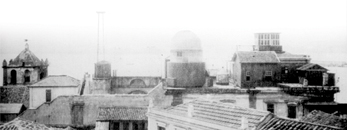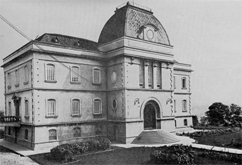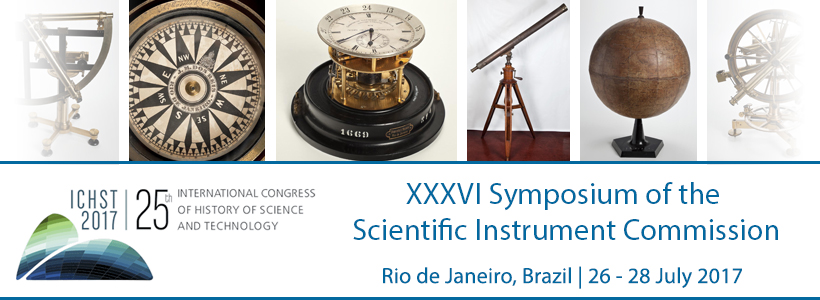National Observatory
During the eighteenth century, the Portuguese government did little to encourage scientific activity in Brazil. It was only after D. João VI arrived in the country, fleeing Napoleon’s invasion of Portugal, and later under the rule of D. Pedro I, that this situation took a turn for the better. Rudimentary astronomical observations were made as of the early nineteenth century at Escola Militar [Military School] in Rio de Janeiro, but it was only on 15 October, 1827 that the Emperor decreed the creation of an astronomical observatory with the purpose of producing astronomical and meteorological data, as well as giving courses in astronomy to students from the military and naval academies.
For different reasons, the observatory only began its work in the middle of the century. It was first based at Escola Militar under the directorship of Soulier de Sauve, who died a year later. It was then transferred to a more suitable location on Castelo hill, Rio de Janeiro, in an unfinished Jesuit church.
In 1846, the observatory was given its official name, Imperial Observatório do Rio de Janeiro, in a decree that also established the work it should undertake. It was to be responsible for making astronomical and meteorological observations, educating and training the students from Escola Militar and Academia da Marinha [Naval Academy], publishing an astronomical yearbook and supplying the right time for ships docked at the port.

After the Paraguay War (1870), Emperor D. Pedro II, who was keen on astronomy, reorganised the observatory and appointed French astronomer Emanuel Liais as its director. This was the beginning of a period during which much work was produced at the observatory and was presented by the director at European academies.
Liais was succeeded by his main collaborator, a Belgian engineer called Luiz Cruls. Under his directorship a number of scientific expeditions were undertaken: to Punta Arenas to observe the transit of Venus across the solar disk (1882); to the Central plateau to demarcate the Brasilia quadrilateral, site of the future capital city (1890); and to the border with Peru and Bolivia to determine the exact location of the source of the Javari river, which was crucial in the conflict between the countries (1898). At the same time, in 1887, the observatory was invited to take part in another major international event also organised by France: to completely map out the celestial dome (Carte du Ciél). The standard scientific instrument needed for this project, an equatorial photographic telescope, was even purchased, but the political upheavals surrounding the proclamation of the Republic in 1889 prevented the observatory from actually taking part in the project. The instrument was never assembled in its original pavilion.
With Brazil a republic, the observatory was renamed Observatório do Rio de Janeiro, and then in 1909, Observatório Nacional [National Observatory], which continues to be its name to this day. At the time, it was entrusted with organising a meteorological service for the entire national territory, much against the wishes of its Director, Henrique Morize. Many meteorology instruments were accordingly acquired by the observatory and are now part of the MAST collection.
The location of the observatory on Castelo hill had been the subject of much debate since the mid 1800s. Reports by its directors had repeatedly pointed to the unsuitability of the site because the land was unstable, making the use of large-scale astronomical instruments unfeasible and severely limiting its activities. A mixture of political factors and plans to modernise the city were instrumental in the decision to finally move it to São Januário hill in the aristocratic district of São Cristóvão.

Work on the new architectural complex was begun in 1913 and completed in 1920, and the following year the observatory was moved there. The remit of the observatory included the following technical and research activities: determining the official time of the country, weather forecasting, astronomical tables, the demarcation of Brazilian borders, systematic observations of solar eclipses from Brazilian territory, magnetic mapping of Brazilian soil and many others. Many different scientific instruments were used for these tasks, which now make up a varied collection with some high quality instruments.
Almost all the directors made an effort to ensure the observatory was supplied with the latest equipment. This culture was passed down from the very first directors during the Imperial era, who had managed to assure the effective engagement of the work carried out at the observatory with the international scenario. The directors were fully aware of the institutional and financial restrictions, and what was needed for the practice of astronomy, but there were countless difficulties to be overcome.
The instruments in the MAST collection and the uses to which they were put give us a good picture of what kind of institution the National Observatory was: what role was envisaged for it and what its activities actually were. An analysis of these instruments shows us what could be done and allows us to draw inferences about the development or in some cases the stagnation, of the methods used. The National Observatory is an active research centre to this day, and still stands on the same historic site in new premises inaugurated in 1985.


